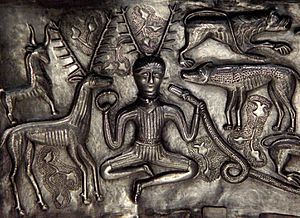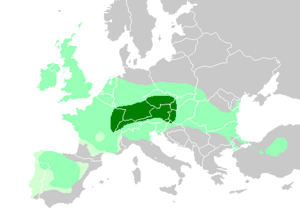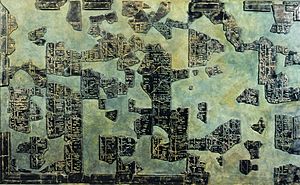Celtic polytheism facts for kids

Celtic polytheism is the name for the ancient religion of the Celts. It is also often called Celtic paganism. The Celts were a group of people who lived across Europe a long time ago. This religion was practiced for about 1,000 years, starting around 500 BC.
This belief system was important during the La Tène period and the time of the Roman Empire. For Celts living in the British Isles, it was also part of their Iron Age. Celtic polytheism was one of many religions from the Indo-European family that believed in many gods.
Contents
Understanding Celtic Beliefs
What is Polytheism?
Polytheism means believing in and worshipping many different gods and goddesses. The Celts had many gods, each with their own special powers and stories. These gods were often linked to nature, like the sun, rivers, or animals.
When Did Celtic Religion Exist?
The earliest signs of Celtic beliefs date back to about 500 BC. This religion lasted for roughly a thousand years. It was important during the La Tène period and continued into the Roman era. In the British Isles, it was also a big part of the Iron Age.
Celtic Gods and Goddesses
Who Were the Main Gods?
We know the names of many Celtic gods from old writings. These writings were made by Ancient Greek and Ancient Roman geographers. Their names have also been found on old stone carvings and graves. Some of the most well-known gods include Teutatis, Taranis, and Lugus.
Gods in Later Stories
Experts who study different mythologies also look at figures from medieval Irish stories. They believe some of these figures were once gods or heroes from even older times. Over time, their stories changed, and they became known in new ways. This process is called Euhemerisation. It means that a god or hero from a myth is later seen as a real historical person.
Religious Practices and Druids
The Role of Druids
The Celts had special religious leaders called druids. These druids were like priests, teachers, and judges all in one. They were very important in Gaul (modern-day France), Britain, and Ireland. We don't know a lot about them today because they didn't write things down. Their knowledge was passed on by word of mouth.
Rituals and Offerings
Celtic religious practices often involved rituals and offerings. These were ways to honor the gods and ask for their help. People might offer valuable items or even animals. These rituals often took place in sacred natural places, like groves of trees or near rivers.
Changes Over Time
Roman Influence
The Roman Empire conquered parts of Celtic lands, like Gaul (around 58-51 BC) and southern Britannia (in 43 AD). After this, Celtic religious practices started to change. They mixed with Roman traditions, creating a new Gallo-Roman culture. This led to new gods being worshipped, like Cernunnos, who became very popular.
The Rise of Christianity
In the 5th and 6th centuries AD, Christianity became the main religion in Celtic areas. It slowly replaced the older Celtic beliefs. However, the old myths and stories still influenced later mythology and folklore. Many ancient Celtic ideas found their way into new Christian traditions.
Modern Celtic Beliefs
In the 20th century, a new religious movement called Celtic Neopaganism appeared. This movement tries to bring back and celebrate ancient Celtic spiritual ideas and practices in a modern way.
Images for kids
-
Image of an antlered figure on the Gundestrup cauldron. Many archaeologists believe this figure is related to the god Cernunnos.
-
An altar found in Reims showing a three-faced god, believed to be Lugus.
-
The "Glauberg Prince" from the 5th century BCE, wearing a torc and a leaf crown. He might have been a hero or an ancestor.
-
A stone head from Mšecké Žehrovice, Czech Republic, wearing a torc. This is from the late La Tène culture.
-
Two druids, from an 1845 book. This image is based on an old carving found at Autun, France.
-
The Beltane festival in Edinburgh, 2019.
See also
 In Spanish: Politeísmo celta para niños
In Spanish: Politeísmo celta para niños












